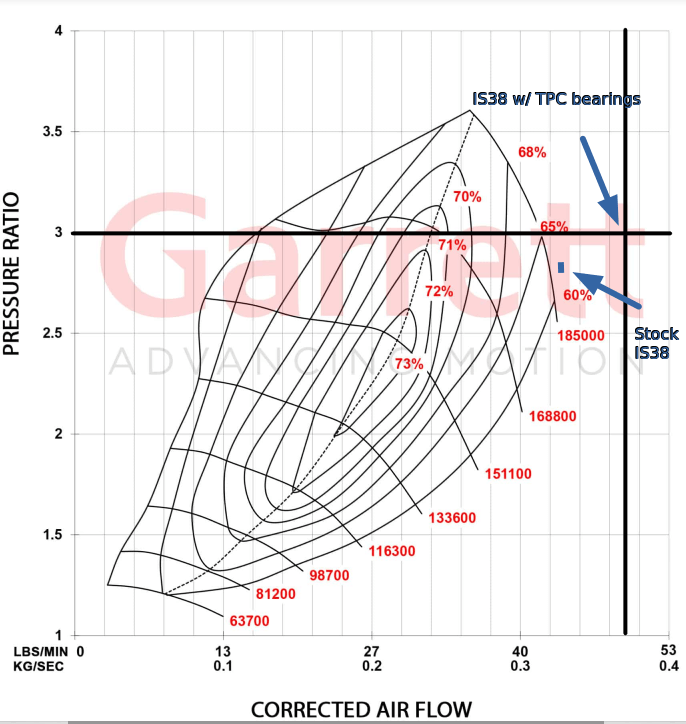Product Claim
Turbo Parts Canada sells an alternative to the stock IHI IS38 turbocharger, the TPC IS38, that has the potential to outperform the stock part with respect to output and reliability.
At one point Turbo Parts Canada (TPC) described their IS38 ball bearing as shown below:
Operating an IS38 turbocharger at 28 psi (or greater) out to redline raised a question of where on a compressor map this operating point would be?
Operating Point Analysis
The IHI IS38 Compressor Wheel size is: 45.2/58 mm (inducer / exducer).
The Turbo Parts Canada ball-bearing IS38 uses the same size compressor as the stock IHI IS38.
Two compressor maps for turbocharger compressors that are close in size will be referenced.
The Garrett GT2260S turbocharger has a compressor that is: 47/60mm.
Compared to the stock IHI IS38 the Garrett is approximately 2 mm larger at the compressor inducer and exducer.
The BorgWarner EFR 6258 turbocharger has a compressor that is: 49.6/61.4mm.
Compared to the stock IHI IS38 the BorgWarner is approximately 4 mm larger at the inducer and 3 mm larger at the exducer.
A larger inducer gives the potential for higher airflow, therefore each of these example compressor maps extends further to the right than an IHI IS38 compressor map would be expected to based upon the compressor wheel size.
Shown on the Garret compressor map is where the stock IHI IS38 at 23.7 psi and 6250 rpm would be operating.
Also shown is the point that TPC claimed the IS38 compressor could be operating when utilizing their ball-bearings and larger shaft instead of the stock journal bearings.
The compressor map for the BorgWarner shows the same information superimposed on it:
What is notable about the TPC IS38 operating point is how far to the right it lies from the compressor choke line.
Normally the turbo enters the region of choking on the map when the inducer throat becomes unable to flow more air.
The Choke Line is the right hand boundary of the compressor map. For Garrett maps, the choke line is typically defined by the point where efficiency drops below 58%. In addition to the rapid drop of compressor efficiency past this point, the turbo speed will also be approaching or exceeding the allowable limit. If your actual or predicted operation is beyond this limit, a larger compressor is necessary.
Garret Turbochargers
A potential benefit of the TPC ball-bearing system would be to operate past the choke line at quickly increasing rotational speeds more reliably than the stock journal bearing turbo, but this would not address the rapidly dropping compressor efficiency.
On the turbine side of the turbocharger, there’s a question of how the expansion ratio increases at the higher rotational speeds necessary to drive the compressor wheel. This would affect the engine’s volumetric efficiency.
Performance Data Evaluation
How this turbocharger performs in operation would be useful to know.
A request was submitted to Turbo Parts Canada for information about measured performance for this product, no answer was given to that request and the business stated they would not discuss the product claims.
After making the company aware that unsubstantiated claims risk violating truth in advertising guidelines, the product description was revised to remove the performance claim that 28 psi of boost can be sustained to redline.
Conclusions
No evidence is provided by the business to support claims of better performance from this turbocharger.
The claim that the turbocharger can sustain 28 psi of boost to redline, increasing performance versus the IHI IS38, is unlikely to be realized based on an analysis of the operating region of two comparable, but larger, turbocharger compressor wheels.
The reliability of the ball-bearing system is not reported by the supplier and will likely never be known accurately. Turbocharger ball-bearings have several attributes that may be beneficial in this application. Responsiveness, durability, and reduced oil requirements are potential attributes that may lead to better performance from the TPC IS38 compared to the journal-bearing-based IHI IS38.



